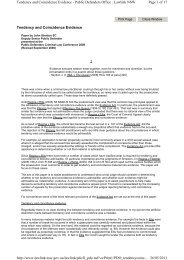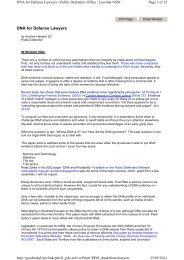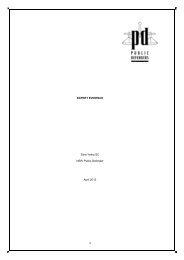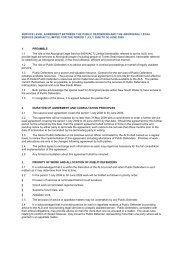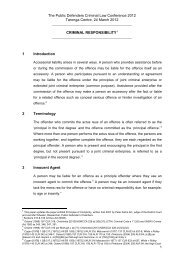Right to Silence: inferences from silence - The Public Defenders
Right to Silence: inferences from silence - The Public Defenders
Right to Silence: inferences from silence - The Public Defenders
Create successful ePaper yourself
Turn your PDF publications into a flip-book with our unique Google optimized e-Paper software.
A suspect who has been arrested should not normally be questioned about his involvement<br />
in an offence except in an interview at a police station, and it is envisaged that questioning <strong>to</strong><br />
which s. 34 applies should occur in the course of such an interview which, being properly<br />
recorded, will then allow the court <strong>to</strong> make reliable deductions about the nature and extent of<br />
any <strong>silence</strong>.<br />
Clearly, if the accused alleges that he did mention the relevant fact when questioned, the<br />
prosecution will have <strong>to</strong> prove the contrary before any adverse inference can be drawn.<br />
Where it is alleged that a ‘significant <strong>silence</strong>’ (i.e. one which appears capable of being used<br />
in evidence against the suspect) has occurred before his arrival at a police station, then at<br />
the beginning of an interview at the station the interviewing officer should put the matter <strong>to</strong><br />
the suspect, under caution, and ask him whether he confirms or denies that earlier <strong>silence</strong><br />
and whether he wishes <strong>to</strong> add anything (para. 11.4). <strong>The</strong> consequence of failing <strong>to</strong> go<br />
through this procedure (which applies <strong>to</strong> evidentially significant statements as it does <strong>to</strong><br />
<strong>silence</strong>s) must be <strong>to</strong> increase significantly the likelihood that the evidence in question will be<br />
excluded under s. 78 if the suspect denies that the earlier statement was made or that the<br />
<strong>silence</strong> occurred.<br />
Furthermore if the suspect is questioned improperly in circumstances prohibited by Code C,<br />
e.g., where sufficient evidence for the accused <strong>to</strong> be charged already exists, s. 34 should not<br />
be brought <strong>to</strong> bear on the suspect’s failure <strong>to</strong> respond (Pointer [1997] Crim LR 676; Gayle<br />
[1999] 2 Cr App R 130). <strong>The</strong>re is a lack of consistency in the authorities on when there is<br />
sufficient evidence for this purpose (see McGuinness [1999] Crim LR 318; Ioannou [1999]<br />
Crim LR 586; Odeyemi [1999] Crim LR 828; Flynn [2001] EWCA Crim 1633; Elliott [2002]<br />
EWCA Crim 931), but no doubt about the principle.<br />
<strong>The</strong> drawing of <strong>inferences</strong> <strong>from</strong> the withholding of a fact at the point of charge under s.<br />
34(1)(b) is a distinct process <strong>from</strong> that under s. 34(1)(a). Where, therefore, no inference<br />
could be drawn <strong>from</strong> <strong>silence</strong> at interview because the interview itself had been excluded<br />
under s.78 PACE 1984, it did not follow that an inference could not be drawn <strong>from</strong> <strong>silence</strong> at<br />
the point of charge as long as there is no unfairness in doing so (Dervish [2002] 2 Cr App R<br />
105). In that case D had the opportunity ‘in a single sentence’ <strong>to</strong> put the essence of his<br />
defence following charge, and the police would thereafter have been precluded <strong>from</strong><br />
questioning him about it. Since he declined <strong>to</strong> do so, it was rightly left <strong>to</strong> the jury <strong>to</strong> decide<br />
whether an inference should be drawn.<br />
Facts which Should Have Been Mentioned<br />
Adverse <strong>inferences</strong> may be drawn <strong>from</strong> a fact subsequently relied on in defence only<br />
where the fact is one which, in the circumstances existing at the time, the accused<br />
could reasonably have been expected <strong>to</strong> mention (s. 34(1)).<br />
If the accused gives evidence, his reason for failing <strong>to</strong> disclose should be explored (T<br />
v DPP (2007) 171 JP 605), and any explanation advanced by the accused for nondisclosure<br />
must be considered in deciding what <strong>inferences</strong>, if any, should be drawn (Webber<br />
[2004] 1 WLR 404, where the House of Lords considered that the jury was ‘very much<br />
concerned’ with the truth or otherwise of an explanation <strong>from</strong> the accused as, if they accept it<br />
as true or possibly so, no adverse inference should be drawn <strong>from</strong> his failure <strong>to</strong> mention it).<br />
Ultimately an adverse inference is appropriate only where the jury concludes that the<br />
<strong>silence</strong> can only sensibly be attributed <strong>to</strong> the defendant’s having no answer, or none<br />
that would stand up <strong>to</strong> questioning (Condron [1997] 1 WLR 827; Betts [2001] 2 Cr App R<br />
257; Daly [2002] 2 Cr App R 201; Petkar [2004] 1 Cr App R 270; Condron v UK (2001) 31<br />
EHRR 1, and Beckles v UK (2003) 36 EHRR 162).<br />
Colin Wells July 2013 Page 10



